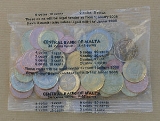
Euro starter kits
Encyclopedia
Euro starter kits are packs of euro coins
of all the eight denominations sealed in a plastic bag. The scope of these kits is primarily to familiarise the citizens of that nation that is going to join the eurozone
with the new currency, the euro. Another objective is to fill up cash registers well in advance of €-Day. Usually these kits are available from the local banks some weeks before the euro changeover.
Mainly there are two types of starter packs; business starter kits and kits for the general public. The difference is in the amount of the coins per pack. Business kits are intended for retailers, thereby they contain around 100 euro or more of coins
and are normally contained in rolls, whereas, the mini-starter kits are intended for the general public and usually these kits have a small volume of coins
.
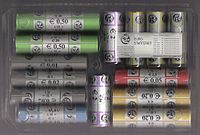
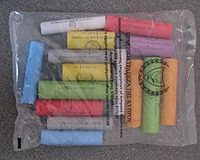 Cyprus together with Malta joined the eurozone
Cyprus together with Malta joined the eurozone
on 1 January 2008. On 3 December 2007, the Central Bank of Cyprus
issued mini-starter packs and business kits, so the Cypriots would have enough euro cash before €-Day.
Forty thousand starter kits, worth €172 each, were available for businesses, but only 22.000 were sold. Since these starter kits contained rolled coins, the remaining kits could easily be used by the banks after €-day. Another 250,000 mini-kits, worth €17.09 (CYP 10) each, were available for the general public. Some 189,000 mini-kits were sold. According to the Eurobarometer survey, more than 70% of the citizens who had bought a mini-kit opened it and used the coins after the changeover while some 20% kept it untouched. As from the changeover, the unsold mini-kits have been exported to satisfy the demand of coin collectors abroad. Cypriot euro coins worth €3.5 million were exported in the first three weeks of January.
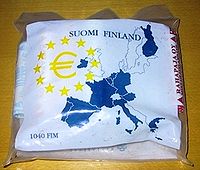
but also was one of the first countries to adopt the euro. The French euro starter packs were available for the public on 14 December 2001. The nominal price of these packs was of 100 French Francs equivalent to €15.25. The kits contained coins from the years 1999, 2000 and 2001.
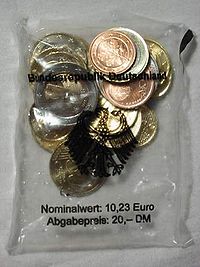 In Germany, each starter kit contained 20 coins for the total of €10.23, equivalent to 20.01 DEM. They were released for the public on 17 December 2001. There are five different kinds of kits, one for each mint (A, D, F, G and J). The following are the mintage quantities per mint:
In Germany, each starter kit contained 20 coins for the total of €10.23, equivalent to 20.01 DEM. They were released for the public on 17 December 2001. There are five different kinds of kits, one for each mint (A, D, F, G and J). The following are the mintage quantities per mint:
 The Greek kit contained coins with a total value of €14.67, or ₯
The Greek kit contained coins with a total value of €14.67, or ₯
5,000. More specifically, it contained:
It contained:
. There are two variations of these packs, one has text printed on the bag, whereas, the other has not.

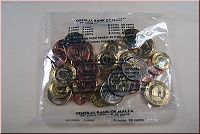 The first Maltese euro coins were available for the public on 1 December 2007, as business starter packs worth €131 each started being available for small businesses to fill up their cash registers with sufficient amount of euro coins before the €-day. Mini-kits each worth €11.65 were available for the general public on 10 December 2007. Malta issued 33,000 business starter kits and 330,000 starter kits for the general public. All the 33,000 starter kits for businesses were sold.
The first Maltese euro coins were available for the public on 1 December 2007, as business starter packs worth €131 each started being available for small businesses to fill up their cash registers with sufficient amount of euro coins before the €-day. Mini-kits each worth €11.65 were available for the general public on 10 December 2007. Malta issued 33,000 business starter kits and 330,000 starter kits for the general public. All the 33,000 starter kits for businesses were sold.
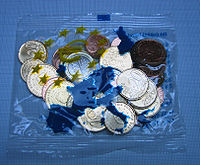 The Netherlands issued two different starter kits, intended to educate its citizens about the euro. One contained one of each coin and was distributed in a card. This was distributed to the citizens of the Netherlands for free. Packaged, mint condition cards have since become collector items. Additional bags of Euro coins could be purchased to familiarise oneself with the coins.
The Netherlands issued two different starter kits, intended to educate its citizens about the euro. One contained one of each coin and was distributed in a card. This was distributed to the citizens of the Netherlands for free. Packaged, mint condition cards have since become collector items. Additional bags of Euro coins could be purchased to familiarise oneself with the coins.
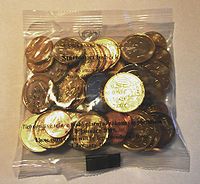 Slovakia joined the eurozone
Slovakia joined the eurozone
on 1 January 2009. As part of the euro changeover preparation, Slovakia issued 1,200,000 starter packs for the general public on 1 December 2008. Each starter kit contains €16.60 in coins this is equivalent to SKK500.09, however, the price was rounded-down to SKK500. The starter kits were available for purchase in the Slovak Post branches, local commercial banks and National Bank of Slovakia. Almost 90% of the Slovak starter kits were sold in the first five days.

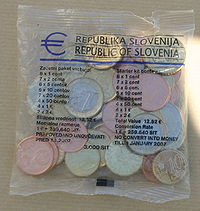 Slovenia was the first country to join the eurozone
Slovenia was the first country to join the eurozone
out of the 10 new member states that joined the European Union
in 2004. On 1 December 2006, professional cash handlers were the first to get hands on the Slovenian euro coins
as special starter packs were available for cash handlers. On 15 December 2006 the general public could buy euro starter kits; 450,000 of these kits were produced, each kit contained 44 coins amounting to €12.52 (3,000 tolars
).
. The Spanish starter kits or “Monedero Euro” had a face value of €12,02 equivalent to 1999.96 pesetas, however, they were sold for 2000 pesetas. These kits were released on 15 December 2001. On 1 September 2001, special starter kits for merchants were issued. The latter had a face value of €30,41 (5060 pesetas).
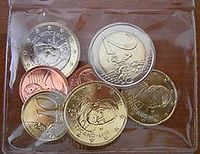 The smallest independent nation in the world, on 1 March 2002 issued 1,000 starter kits. It was the only nation to issue starter kits well after the eurochangeover, thus, these starter kits are collectible items. Each kit consisted of eight coins, one coin of each denomination (€0,01 – €2,00), thereby, having a face value of €3,88 and all depict the now late pope, John Paul II. Although these packs were available for free, nowadays, their price on commercial websites is significant. With only 1,000 issues, this is the rarest starter kit.
The smallest independent nation in the world, on 1 March 2002 issued 1,000 starter kits. It was the only nation to issue starter kits well after the eurochangeover, thus, these starter kits are collectible items. Each kit consisted of eight coins, one coin of each denomination (€0,01 – €2,00), thereby, having a face value of €3,88 and all depict the now late pope, John Paul II. Although these packs were available for free, nowadays, their price on commercial websites is significant. With only 1,000 issues, this is the rarest starter kit.
In 2008, surprisingly, the Vatican City released 6,400 'starter kits', however, this time the coins featured Benedict XVI. Each kit contains eight coins, again a coin of each denomination, and was given to the inhabitants and employees of the Vatican for free.
Business Starter Kits
Euro coins
There are eight euro coin denominations, ranging from one cent to two euros . The coins first came into use in 2002. They have a common reverse, portraying a map of Europe, but each country in the eurozone has its own design on the obverse, which means that each coin has a variety of different...
of all the eight denominations sealed in a plastic bag. The scope of these kits is primarily to familiarise the citizens of that nation that is going to join the eurozone
Eurozone
The eurozone , officially called the euro area, is an economic and monetary union of seventeen European Union member states that have adopted the euro as their common currency and sole legal tender...
with the new currency, the euro. Another objective is to fill up cash registers well in advance of €-Day. Usually these kits are available from the local banks some weeks before the euro changeover.
Mainly there are two types of starter packs; business starter kits and kits for the general public. The difference is in the amount of the coins per pack. Business kits are intended for retailers, thereby they contain around 100 euro or more of coins
COinS
ContextObjects in Spans, commonly abbreviated COinS, is a method to embed bibliographic metadata in the HTML code of web pages. This allows bibliographic software to publish machine-readable bibliographic items and client reference management software to retrieve bibliographic metadata. The...
and are normally contained in rolls, whereas, the mini-starter kits are intended for the general public and usually these kits have a small volume of coins
COinS
ContextObjects in Spans, commonly abbreviated COinS, is a method to embed bibliographic metadata in the HTML code of web pages. This allows bibliographic software to publish machine-readable bibliographic items and client reference management software to retrieve bibliographic metadata. The...
.
Austria
The Austrian euro starter kits were out on the 15 December 2001. The general public kit was sold for €14.54 (200,07 ATS, however, rounded to 200 ATS), whereas, the business starter kits were available much earlier, on 1 September 2001 and each kit contained €145 in Austrian euro coins. The quantity of the public and business starter kits produced was 6,000,000 and 750,000 kits, respectively.Belgium
The Belgian starter kits were sold at 500 Belgian Francs.
Cyprus

Eurozone
The eurozone , officially called the euro area, is an economic and monetary union of seventeen European Union member states that have adopted the euro as their common currency and sole legal tender...
on 1 January 2008. On 3 December 2007, the Central Bank of Cyprus
Central Bank of Cyprus
The Central Bank of Cyprus , is the central bank of the Republic of Cyprus, located in Nicosia. It was established in 1963. Its current governor is Mr. Athanasios Orphanides...
issued mini-starter packs and business kits, so the Cypriots would have enough euro cash before €-Day.
Forty thousand starter kits, worth €172 each, were available for businesses, but only 22.000 were sold. Since these starter kits contained rolled coins, the remaining kits could easily be used by the banks after €-day. Another 250,000 mini-kits, worth €17.09 (CYP 10) each, were available for the general public. Some 189,000 mini-kits were sold. According to the Eurobarometer survey, more than 70% of the citizens who had bought a mini-kit opened it and used the coins after the changeover while some 20% kept it untouched. As from the changeover, the unsold mini-kits have been exported to satisfy the demand of coin collectors abroad. Cypriot euro coins worth €3.5 million were exported in the first three weeks of January.
| Starter Kit | €2.00 | €1.00 | €0.50 | €0.20 | €0.10 | €0.05 | €0.02 | € 0.01 | Face Value | Issue Date | Quantity |
|---|---|---|---|---|---|---|---|---|---|---|---|
| Business Starter Kit | 1 Roll (25 coins) | 2 Rolls (50 coins) | 2 Rolls (80 coins) | 2 Rolls (80 coins) | 2 Rolls (80 coins) | 2 Rolls (100 coins) | 2 Rolls (100 coins) | 2 Rolls (100 coins) | €172,00 | 03.12.2007 | 40,000 |
| Public mini-Starter Kit | 3 coins | 5 coins | 7 coins | 8 coins | 5 coins | 6 coins | 6 coins | 7 coins | €17,09 | 03.12.2007 | 250,000 |
Estonia
Estonia joined the eurozone on 1 January 2011. It was the 17th member state of the eurozone. Mini-euro starter kits were issued on 1 December 2010 and it has also issued 2 types of business kits. One business kit contains €111 worth of coins and packed in rolls, whereas, the other kit contains 15 rolls worth €198| Starter Kit | €2.00 | €1.00 | €0.50 | €0.20 | €0.10 | €0.05 | €0.02 | € 0.01 | Face Value | Issue Date | Quantity |
|---|---|---|---|---|---|---|---|---|---|---|---|
| Public mini-Starter Kit | 2 coins | 4 coins | 5 coins | 6 coins | 6 coins | 6 coins | 6 coins | 7 coins | €12.79 | 01.12.2010 | 700,000 |
| Business mini-Starter Kit | 1 roll (25 coins) |
1 roll (25 coins) |
1 roll (40 coins) |
1 roll (40 coins) |
1 roll (40 coins) |
1 roll (50 coins) |
1 roll (50 coins) |
1 roll (50 coins) |
€111.00 | 01.12.2010 | ? |
Finland

| Starter Kit | €2.00 | €1.00 | €0.50 | €0.20 | €0.10 | €0.05 | €0.02 | € 0.01 | Face Value | Issue Date | Quantity |
|---|---|---|---|---|---|---|---|---|---|---|---|
| Business Starter Kit | 1 roll (25 coins) |
1 roll (25 coins) |
3 rolls (120 coins) |
2 rolls (80 coins) |
3 rolls (120 coins) |
2 rolls (100 coins) |
– |
– |
€168.00 | 01.01.2002 | ? |
| Public mini-Starter Kit | 1 coin | 1 coin | 1 coin | 1 coin | 1 coin | 1 coin | 1 coin | 1 coin | €3.88 | 01.01.2002 | 500,000 |
France
France was not just one of the founders of the European UnionEuropean Union
The European Union is an economic and political union of 27 independent member states which are located primarily in Europe. The EU traces its origins from the European Coal and Steel Community and the European Economic Community , formed by six countries in 1958...
but also was one of the first countries to adopt the euro. The French euro starter packs were available for the public on 14 December 2001. The nominal price of these packs was of 100 French Francs equivalent to €15.25. The kits contained coins from the years 1999, 2000 and 2001.
| Starter Kit | €2.00 | €1.00 | €0.50 | €0.20 | €0.10 | €0.05 | €0.02 | € 0.01 | Face Value | Issue Date | Quantity |
|---|---|---|---|---|---|---|---|---|---|---|---|
| Public mini-Starter Kit | 4 coins | 3 coins | 4 coins | 7 coins | 4 coins | 5 coins | 7 coins | 6 coins | €15.25 | 14.12.2001 | 53,000,000 |
Germany

- A : 12,100,000 Kits
- D : 11,600,000 Kits
- F : 12,100,000 Kits
- G : 8,100,000 Kits
- J : 9,600,000 Kits
Greece

Greek drachma
Drachma, pl. drachmas or drachmae was the currency used in Greece during several periods in its history:...
5,000. More specifically, it contained:
- €2.00 x 2
- €1.00 x 5
- €0.50 x 6
- €0.20 x 7
- €0.10 x 8
- €0.05 x 6
- €0.02 x 6
- €0.01 x 5
Ireland
Ireland issued 750,000 starter packs on 14 December 2001. Each starter pack contained 18 coins worth €6.35 in total, or IR£5.It contained:
- €2.00 * 1
- €1.00 * 2
- €0.50 * 2
- €0.20 * 4
- €0.10 * 4
- €0.05 * 2
- €0.02 * 1
- €0.01 * 3
Italy
Italy issued 30,000,000 starter kits, each starter kit had a face value of 12,91€ equivalent to 25,000 Italian LiraItalian lira
The lira was the currency of Italy between 1861 and 2002. Between 1999 and 2002, the Italian lira was officially a “national subunit” of the euro...
. There are two variations of these packs, one has text printed on the bag, whereas, the other has not.
Luxembourg
Except for different text on the bag and different national sides, Luxembourg's starter sets were the same as the Belgian sets, as Belgium and Luxembourg were already in a pre-existing currency union. Each set also had 500 francs in euro coins.Malta


| Starter Kit | €2.00 | €1.00 | €0.50 | €0.20 | €0.10 | €0.05 | €0.02 | € 0.01 | Face Value | Issue Date | Quantity |
|---|---|---|---|---|---|---|---|---|---|---|---|
| Business Starter Kit | 1 roll (25 coins) |
1 roll (25 coins) |
1 roll (40 coins) |
2 rolls (80 coins) |
3 rolls (120 coins) |
2 rolls (100 coins) |
2 rolls (100 coins) |
2 rolls (100 coins) |
€131.00 | 01.12.2007 | 33,000 |
| Public mini-Starter Kit | 2 coins | 3 coins | 5 coins | 6 coins | 6 coins | 5 coins | 3 coins | 4 coins | €11.65 | 10.12.2007 | 330,000 |
Monaco
Despite not being a member of the European Union, in 1999 Monaco also adopted the euro. This is mainly because Monaco never had its own currency and was using the French one, so when France switched to the euro Monaco had no option but to follow suit. The European Union has a special agreement with Monaco that allows this country to mint a limited number of euro coins. Late in 2001, Monaco issued 51,200 starter kits for the nominal price of €15,25 (100 francs) each, however, today their price on commercial websites is more than €600.Netherlands

Portugal
One million starter kits containing the Portuguese euro coins were available on 17 December 2001. Each kit was sold for 2005 PTE (equivalent to €10). On 1 September 2001 business kits with €250 of euro coins were available.San Marino
San Marino in 2002 was among those non-EU nations that joined the euro. Out of all the countries that switched to the euro, San Marino was the only country not to issue a euro starter kit.Slovakia

Eurozone
The eurozone , officially called the euro area, is an economic and monetary union of seventeen European Union member states that have adopted the euro as their common currency and sole legal tender...
on 1 January 2009. As part of the euro changeover preparation, Slovakia issued 1,200,000 starter packs for the general public on 1 December 2008. Each starter kit contains €16.60 in coins this is equivalent to SKK500.09, however, the price was rounded-down to SKK500. The starter kits were available for purchase in the Slovak Post branches, local commercial banks and National Bank of Slovakia. Almost 90% of the Slovak starter kits were sold in the first five days.
| Starter Kit | €2.00 | €1.00 | €0.50 | €0.20 | €0.10 | €0.05 | €0.02 | € 0.01 | Face Value | Issue Date | Quantity |
|---|---|---|---|---|---|---|---|---|---|---|---|
| Slovakia mini-Starter Kit | 2 coins |
6 coins |
8 coins |
8 coins |
6 coins |
5 coins |
5 coins |
5 coins |
€16.60 | 01.12.2008 | 1,200,000 |
Slovenia


Eurozone
The eurozone , officially called the euro area, is an economic and monetary union of seventeen European Union member states that have adopted the euro as their common currency and sole legal tender...
out of the 10 new member states that joined the European Union
European Union
The European Union is an economic and political union of 27 independent member states which are located primarily in Europe. The EU traces its origins from the European Coal and Steel Community and the European Economic Community , formed by six countries in 1958...
in 2004. On 1 December 2006, professional cash handlers were the first to get hands on the Slovenian euro coins
Slovenian euro coins
Slovenian euro coins were first issued for circulation on 1 January 2007 and a unique feature is designed for each coin. The design of approximately 230 million Slovenian euro coins was unveiled on 7 October 2005. The designers were Miljenko Licul, Maja Licul and Janez Boljka...
as special starter packs were available for cash handlers. On 15 December 2006 the general public could buy euro starter kits; 450,000 of these kits were produced, each kit contained 44 coins amounting to €12.52 (3,000 tolars
Slovenian tolar
The tolar was the currency of Slovenia from 1991 until the introduction of the euro on 1 January 2007. It was subdivided into 100 stotins...
).
| Starter Kit | €2.00 | €1.00 | €0.50 | €0.20 | €0.10 | €0.05 | €0.02 | € 0.01 | Face Value | Issue Date | Quantity |
|---|---|---|---|---|---|---|---|---|---|---|---|
| Professional Cash Handlers Starter Kit | 1 roll (25 coins) | 3 rolls (75 coins) | 2 rolls (80 coins) | 2 rolls (80 coins) | 3 rolls (120 coins) | 2 rolls (100 coins) | 2 rolls (100 coins) | 2 rolls (100 coins) | €201.00 | 01.12.2006 | 45,000 |
| Public mini-Starter Kit | 2 coins | 4 coins | 4 coins | 7 coins | 6 coins | 6 coins | 7 coins | 8 coins | €12.52 | 15.12.2006 | 450,000 |
Spain
Spain was one of the first countries to join the eurozoneEurozone
The eurozone , officially called the euro area, is an economic and monetary union of seventeen European Union member states that have adopted the euro as their common currency and sole legal tender...
. The Spanish starter kits or “Monedero Euro” had a face value of €12,02 equivalent to 1999.96 pesetas, however, they were sold for 2000 pesetas. These kits were released on 15 December 2001. On 1 September 2001, special starter kits for merchants were issued. The latter had a face value of €30,41 (5060 pesetas).
| Starter Kit | €2.00 | €1.00 | €0.50 | €0.20 | €0.10 | €0.05 | €0.02 | € 0.01 | Face Value | Issue Date | Quantity |
|---|---|---|---|---|---|---|---|---|---|---|---|
| Business Starter Kit | €30.41 | 01.09.2001 | 3,500,000 | ||||||||
| Public mini-Starter Kit | 2 coins | 2 coins | 7 coins | 7 coins | 6 coins | 6 coins | 9 coins | 4 coins | €12.02 | 15.12.2001 | 23,000,000 |
Vatican

In 2008, surprisingly, the Vatican City released 6,400 'starter kits', however, this time the coins featured Benedict XVI. Each kit contains eight coins, again a coin of each denomination, and was given to the inhabitants and employees of the Vatican for free.
| Starter Kit | €2.00 | €1.00 | €0.50 | €0.20 | €0.10 | €0.05 | €0.02 | € 0.01 | Face Value | Issue Date | Quantity |
|---|---|---|---|---|---|---|---|---|---|---|---|
| Vatican Starter Kit 2002 | 1 coin |
1 coin |
1 coin |
1 coin |
1 coin |
1 coin |
1 coin |
1 coin |
€3,88 | 01.03.2001 | 1,000 |
| Vatican Starter Kit 2008 | 1 coin |
1 coin |
1 coin |
1 coin |
1 coin |
1 coin |
1 coin |
1 coin |
€3,88 | unknown.2008 | 6,400 |
Summary
General Public mini-Starter Kits| Country | Coins | 2€ | 1€ | 50 | 20 | 10 | 5 | 2 | 1 | Face Value | Quantity | |
| Austria | 33 | 4 | 4 | 2 | 3 | 6 | 4 | 4 | 6 | €14.54 | 200 ATS | 6,000,000 |
| Belgium | 29 | 2 | 5 | 4 | 3 | 5 | 4 | 4 | 2 | €12.40 | 500 BEF | 5,300,000 |
| Cyprus | 47 | 3 | 5 | 7 | 8 | 5 | 6 | 6 | 7 | €17.09 | 10 CYP | 250,000 |
| Estonia | 42 | 2 | 4 | 5 | 6 | 6 | 6 | 6 | 7 | €12,79 | 200 EEK | 700,000 |
| Finland | 8 | 1 | 1 | 1 | 1 | 1 | 1 | 1 | 1 | €3.88 | 23 FIM | 500,000 |
| France | 40 | 4 | 3 | 4 | 7 | 4 | 5 | 7 | 6 | €15.25 | 100 FRF | 53,000,000 |
| Germany | 20 | 2 | 3 | 4 | 4 | 3 | 2 | 1 | 1 | €10.23 | 20 DEM | 53,542,150 |
| Greece | 45 | 2 | 5 | 6 | 7 | 8 | 6 | 6 | 5 | €14.67 | 5000 GRD | 3,000,000 |
| Ireland | 19 | 1 | 2 | 2 | 4 | 4 | 2 | 1 | 3 | €6.35 | 5 IEP | 750,000 |
| Italy | 53 | 2 | 4 | 5 | 5 | 6 | 10 | 10 | 11 | €12.91 | 25000 ITL | 30,000,000 |
| Luxembourg | 29 | 2 | 5 | 4 | 3 | 5 | 4 | 4 | 2 | €12.40 | 500 LUF | 700,000 |
| Malta | 34 | 2 | 3 | 5 | 6 | 6 | 5 | 3 | 4 | €11.65 | 5 MTL | 330,000 |
| Monaco | 40 | 4 | 3 | 4 | 7 | 4 | 5 | 7 | 6 | €15.25 | 100 FRF | 51,200 |
| Netherlands | 8 | 1 | 1 | 1 | 1 | 1 | 1 | 1 | 1 | €3.88 | Free | 16,000,000 |
| Netherlands | 32 | 2 | 3 | 5 | 5 | 5 | 5 | 3 | 4 | €11.35 | 25 NLG | 8,800,000 |
| Portugal | 34 | 2 | 2 | 4 | 5 | 6 | 5 | 5 | 5 | €10.00 | 2005 PTE | 1,000,000 |
| Slovakia | 45 | 2 | 6 | 8 | 8 | 6 | 5 | 5 | 5 | €16.60 | 500 SKK | 1,200,000 |
| Slovenia | 44 | 2 | 4 | 4 | 7 | 6 | 6 | 7 | 8 | €12.52 | 3000 SIT | 450,000 |
| Spain | 43 | 2 | 2 | 7 | 7 | 6 | 6 | 9 | 4 | €12.02 | 2000 ESP | 23,000,000 |
| Vatican 2002 | 8 | 1 | 1 | 1 | 1 | 1 | 1 | 1 | 1 | €3.88 | Free | 1,000 |
| Vatican 2008 | 8 | 1 | 1 | 1 | 1 | 1 | 1 | 1 | 1 | €3.88 | Free | 6,400 |
Business Starter Kits
| Country | Rolls | 2€ | 1€ | 50 | 20 | 10 | 5 | 2 | 1 | Face Value | Quantity | |
| Cyprus | 15 | 1 | 2 | 2 | 2 | 2 | 2 | 2 | 2 | €172 | 100.67 CYP | 40,000 |
| Finland | 12 | 1 | 1 | 3 | 2 | 3 | 2 | |||||
| €168 | 1040 FIM | ? | ||||||||||
| Malta | 14 | 1 | 1 | 1 | 2 | 3 | 2 | 2 | 2 | €131 | 56.24 MTL | 33,000 |
| Portugal | ? | ? | ? | ? | ? | ? | ? | ? | ? | €250 | ? PTE | ? |
| Slovenia | 17 | 1 | 3 | 2 | 2 | 3 | 2 | 2 | 2 | €201 | 48,167 SIT | 45,000 |
| Spain | ? | ? | ? | ? | ? | ? | ? | ? | ? | €30.41 | 5,060 ESP | 3,500,000 |

